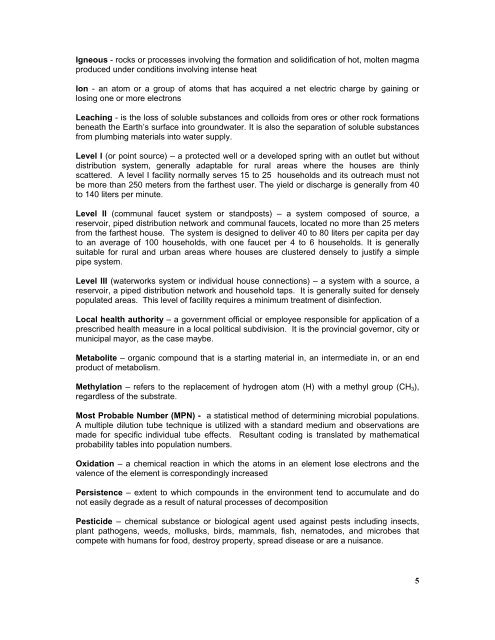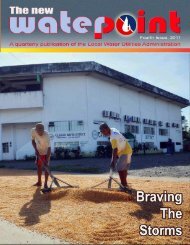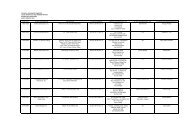Philippine National Standards for Drinking Water - LWUA
Philippine National Standards for Drinking Water - LWUA
Philippine National Standards for Drinking Water - LWUA
Create successful ePaper yourself
Turn your PDF publications into a flip-book with our unique Google optimized e-Paper software.
Igneous - rocks or processes involving the <strong>for</strong>mation and solidification of hot, molten magma<br />
produced under conditions involving intense heat<br />
Ion - an atom or a group of atoms that has acquired a net electric charge by gaining or<br />
losing one or more electrons<br />
Leaching - is the loss of soluble substances and colloids from ores or other rock <strong>for</strong>mations<br />
beneath the Earth’s surface into groundwater. It is also the separation of soluble substances<br />
from plumbing materials into water supply.<br />
Level I (or point source) – a protected well or a developed spring with an outlet but without<br />
distribution system, generally adaptable <strong>for</strong> rural areas where the houses are thinly<br />
scattered. A level I facility normally serves 15 to 25 households and its outreach must not<br />
be more than 250 meters from the farthest user. The yield or discharge is generally from 40<br />
to 140 liters per minute.<br />
Level II (communal faucet system or standposts) – a system composed of source, a<br />
reservoir, piped distribution network and communal faucets, located no more than 25 meters<br />
from the farthest house. The system is designed to deliver 40 to 80 liters per capita per day<br />
to an average of 100 households, with one faucet per 4 to 6 households. It is generally<br />
suitable <strong>for</strong> rural and urban areas where houses are clustered densely to justify a simple<br />
pipe system.<br />
Level III (waterworks system or individual house connections) – a system with a source, a<br />
reservoir, a piped distribution network and household taps. It is generally suited <strong>for</strong> densely<br />
populated areas. This level of facility requires a minimum treatment of disinfection.<br />
Local health authority – a government official or employee responsible <strong>for</strong> application of a<br />
prescribed health measure in a local political subdivision. It is the provincial governor, city or<br />
municipal mayor, as the case maybe.<br />
Metabolite – organic compound that is a starting material in, an intermediate in, or an end<br />
product of metabolism.<br />
Methylation – refers to the replacement of hydrogen atom (H) with a methyl group (CH 3 ),<br />
regardless of the substrate.<br />
Most Probable Number (MPN) - a statistical method of determining microbial populations.<br />
A multiple dilution tube technique is utilized with a standard medium and observations are<br />
made <strong>for</strong> specific individual tube effects. Resultant coding is translated by mathematical<br />
probability tables into population numbers.<br />
Oxidation – a chemical reaction in which the atoms in an element lose electrons and the<br />
valence of the element is correspondingly increased<br />
Persistence – extent to which compounds in the environment tend to accumulate and do<br />
not easily degrade as a result of natural processes of decomposition<br />
Pesticide – chemical substance or biological agent used against pests including insects,<br />
plant pathogens, weeds, mollusks, birds, mammals, fish, nematodes, and microbes that<br />
compete with humans <strong>for</strong> food, destroy property, spread disease or are a nuisance.<br />
5







